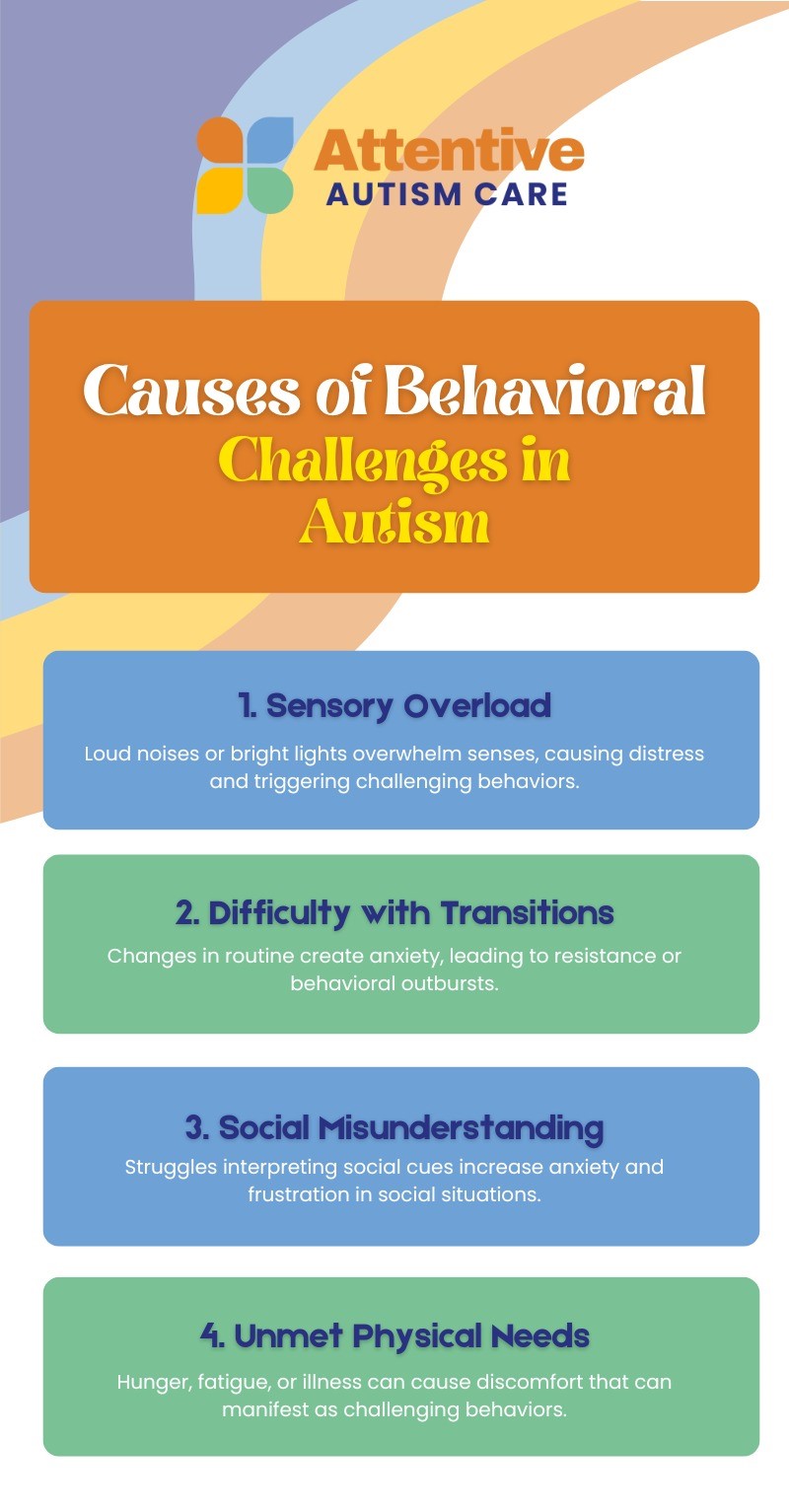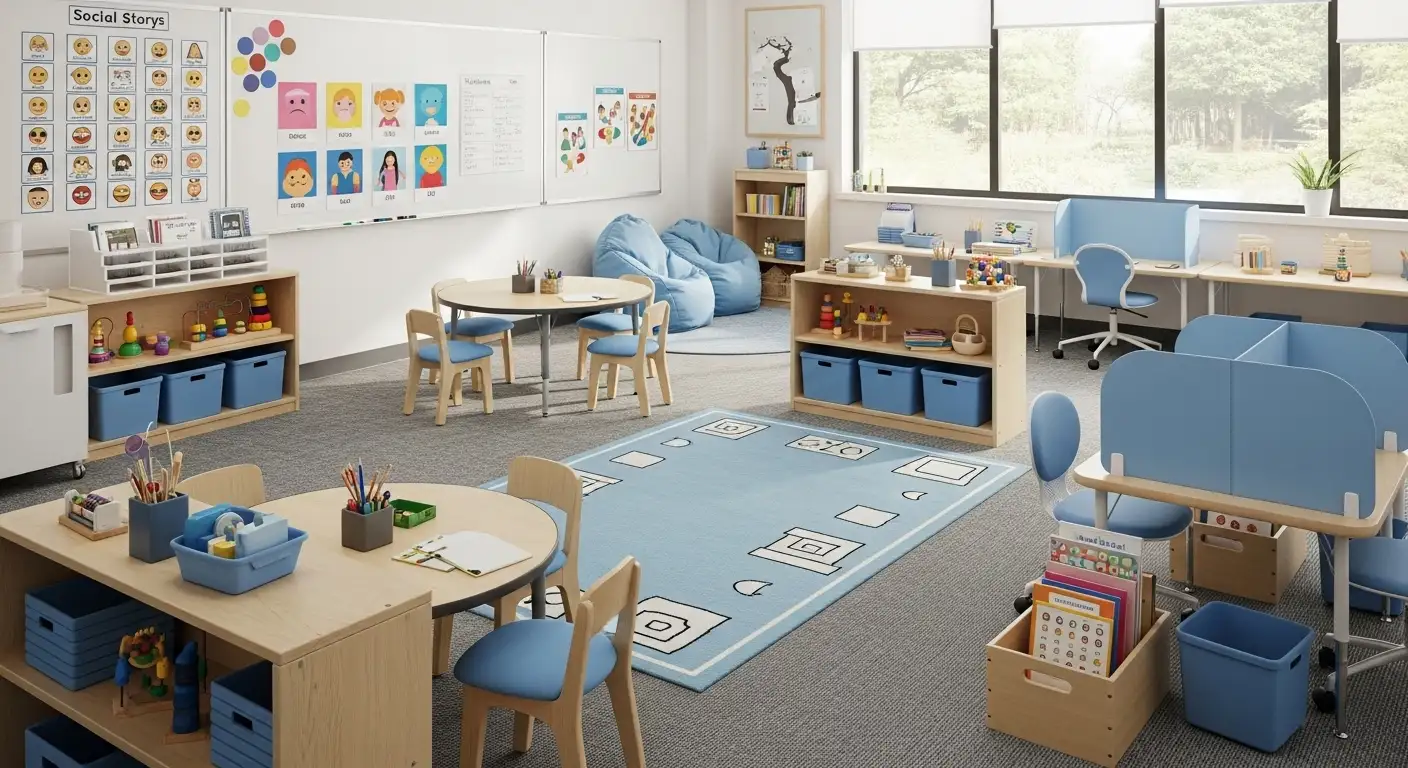Why Behavioral Challenges in Autism Happen and How to Help
Addressing autism-related behavioral challenges with insights and practical approaches.

Key Points:
- Behavioral challenges in autism are often tied to difficulties in communication, sensory regulation, or emotional expression.
- Understanding the root causes of these behaviors is key to providing appropriate interventions.
- Evidence-based strategies like ABA therapy can help reduce challenging behaviors and teach adaptive skills.
Children and adults with autism often experience a range of behavioral challenges that affect their ability to navigate daily life. These behaviors can be distressing for both the individual and their caregivers.
According to research, up to 30% autistic individuals exhibit self-injurious behavior, making awareness and support for behavioral concerns more important than ever. Challenging behaviors are often a form of communication, especially when verbal expression is limited.
In this article, we’ll explore the causes, types, and solutions to help families better support their loved ones with autism.
What are the Behavioral Challenges in Autism?
Behavioral challenges in autism often include aggression, self-injurious behaviors, tantrums, property destruction, and noncompliance. These behaviors vary in intensity and frequency and are influenced by internal and external factors like sensory input, unmet needs, or environmental changes.
Understanding behavioral challenges in autism requires a compassionate and individualized approach. Most behaviors have a purpose, whether it’s escaping an overwhelming task, gaining attention, or communicating a physical need. Identifying patterns and triggers is the first step to addressing them effectively.
What Causes Challenging Behaviors in Individuals With Autism?
Autistic individuals may struggle with communication, sensory processing, and emotional regulation—all of which contribute to behavioral challenges. When a child cannot express their discomfort, frustration, or confusion with words, behaviors often become their voice.
These root causes are often interrelated and may include:

By identifying and understanding these causes, caregivers and professionals can choose more effective interventions.
When Should Parents Seek Professional Support?
Parents should consider seeking professional support if their child shows persistent delays in communication, social skills, or behavior that interfere with daily life. Signs include a lack of response to their name, limited speech, frequent meltdowns, or difficulty adapting to changes.
Early evaluation by specialists such as pediatricians, psychologists, or speech therapists can provide an accurate diagnosis and guidance. Professional support is crucial for creating tailored interventions, accessing resources, and improving long-term outcomes. Don’t hesitate to reach out if you notice developmental concerns—early intervention makes a significant difference.
Common Behavioral Challenges in Autism
Behavioral challenges in autism can vary widely, reflecting each child’s unique needs, sensory experiences, and communication abilities. These behaviors often serve as a form of expression when verbal communication is limited or when overwhelming sensory input triggers distress.
Common challenges include:
1. Tantrums and Meltdowns
Intense emotional outbursts often result from sensory overload or frustration. Meltdowns differ from tantrums as they are involuntary responses to overwhelming situations, not attempts to manipulate or gain attention.
2. Self-Injurious Behavior (SIB)
Behaviors like head banging or biting oneself may be coping mechanisms to manage pain, anxiety, or sensory discomfort. Understanding triggers is key to providing safer alternatives and support.
3. Aggression Toward Others
Aggressive actions can stem from communication difficulties, frustration, or sensory distress. Addressing underlying causes helps reduce incidents and promotes safer social interactions.
4. Property Destruction
Breaking or damaging objects may be a way to express unmet needs or release tension. Identifying triggers allows caregivers to implement preventative strategies.
5. Repetitive or Ritualistic Behaviors
Repetitive behaviors or strict routines provide comfort and predictability. These behaviors help regulate emotions but can interfere with flexibility and social engagement.
6. Noncompliance or Avoidance
Refusal or withdrawal often signals discomfort, anxiety, or a desire to escape overwhelming situations. Recognizing this helps shift focus from punishment to support.
Each behavior should be viewed through the lens of communication and need rather than defiance or intent.

How Can Parents and Caregivers Respond Effectively?
Reacting to challenging behavior requires calmness, consistency, and an understanding of the underlying cause. Punishment alone is not effective, and often escalates the behavior. Instead, evidence-based strategies can reduce behaviors and build skills.
Here are effective ways to respond:
1. Stay Calm and Consistent
Maintaining calm and consistent reactions helps de-escalate situations. Modeling emotional regulation teaches children how to manage their feelings, reducing the intensity and frequency of challenging behaviors over time.
2. Use Visual Supports
Visual tools like schedules, timers, and picture cards provide clear expectations and structure. They help children understand transitions and routines, reducing anxiety and preventing behavioral outbursts.
3. Validate Emotions
Acknowledging your child’s feelings—even when behavior is inappropriate—builds trust and emotional awareness. Validating emotions helps children feel understood, which can decrease frustration and improve cooperation.
4. Offer Choices
Presenting two acceptable options empowers children and increases their sense of control. Offering choices encourages cooperation and reduces resistance by giving children a voice in decision-making.
5. Reinforce Positive Behavior
Recognize and reward appropriate behaviors consistently. Positive reinforcement motivates children to repeat good behaviors and supports skill development more effectively than punishment.
Creating a proactive support system can prevent many behaviors before they escalate.

Evidence-Based Interventions That Help
Applied Behavior Analysis (ABA) is one of the most widely supported therapies for addressing behavioral challenges in individuals with autism. ABA focuses on understanding the function of behavior and teaching alternative, more adaptive behaviors.
Other effective interventions include:
1. Applied Behavior Analysis (ABA)
ABA uses data-driven techniques to identify behavior functions and teach alternative skills. It promotes positive behaviors through reinforcement and reduces challenging behaviors by addressing their root causes systematically.
2. Speech and Language Therapy
This therapy targets communication challenges, helping individuals express needs and emotions more effectively. Improved communication often reduces frustration-driven behaviors and enhances social interaction skills.
3. Occupational Therapy
Occupational therapy supports sensory processing and daily living skills, helping individuals manage sensory sensitivities and improve independence, which can decrease behavioral outbursts related to sensory overload.
4. Social Skills Training
Focused on peer interaction and relationship-building, social skills training teaches appropriate social behaviors, conversation skills, and emotional understanding, reducing social anxiety and improving inclusion.
5. Parent Training and Coaching
Training equips parents with strategies to maintain consistency and reinforce positive behaviors at home, creating a supportive environment that enhances therapeutic gains across settings.
Combining multiple interventions often leads to the most sustainable progress.
How Can Parents Effectively Teach Replacement Behaviors?
Teaching replacement behaviors begins with understanding why a child engages in challenging behaviors. Parents should identify the purpose behind these actions—whether to gain attention, escape a task, or self-soothe. Once the function is clear, parents can model and teach appropriate alternative behaviors that meet the same need in a safer, more effective way.
Consistency is essential. Breaking new skills into manageable steps and reinforcing progress with praise or rewards encourages learning. Practicing replacement behaviors in real-life situations helps children generalize skills. Patience, calm guidance, and regular encouragement support lasting positive change.
Reinforce Positive Habits With ABA Therapy
Attentive Autism Care offers personalized ABA therapy tailored to your child’s unique strengths and needs. Whether your child struggles with meltdowns, communication, or daily routines, we’re here to help.
We proudly provide ABA therapy in Utah, Colorado, North Carolina, Maryland, New Mexico, and Nebraska.
Contact us today to learn more about how our expert team can support your family through structured, compassionate, and effective autism care.




































































































